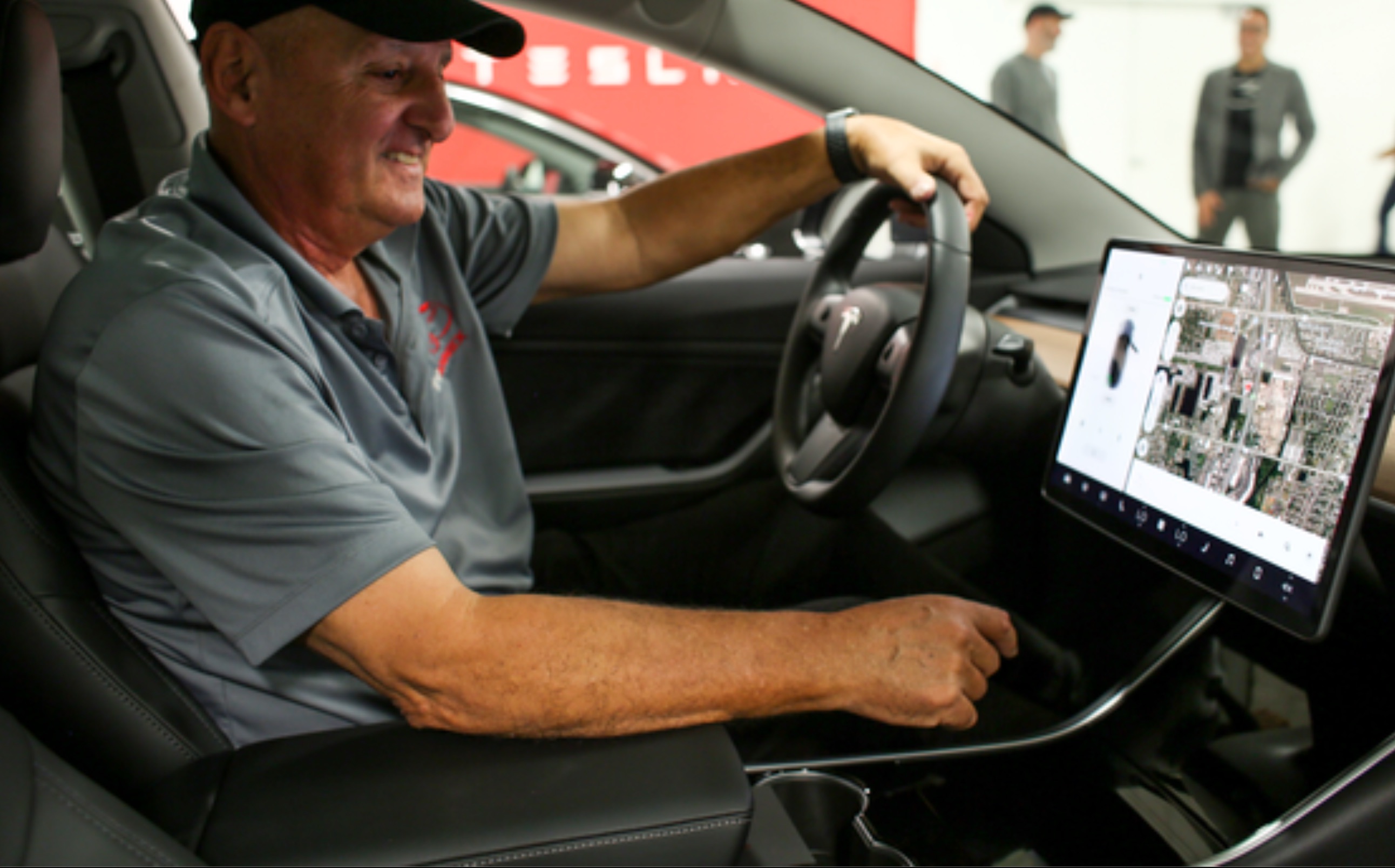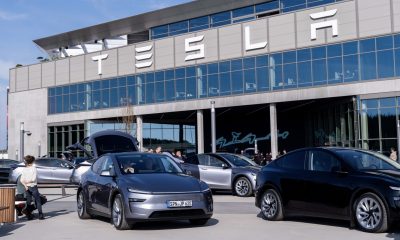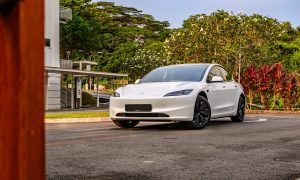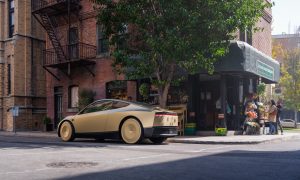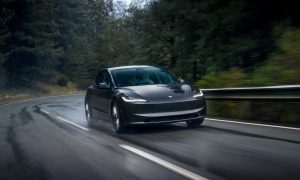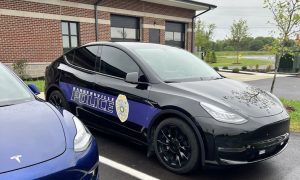Lots of reviews discuss Model 3—its performance and driving attributes, its interior and exterior design, the basic functionality achieved through the landscape display and a myriad of other features.
I’ve now been driving my Model 3, one of the first in South Florida, for about a week, and I’d like to share some of my observations about the car, without repeating what most of you may already know after seeing reviews performed by mass media and big name Youtubers.
 |
Above: There it is… my midnight silver Model 3 delivery at Tesla’s service center in Dania Beach, Florida (Photo: EVANNEX)
First, the big picture—Model 3 is a truly transformational vehicle. It provides high performance, long range, and a premium aesthetic at a broadly affordable price. But you already knew that. Let me talk about what you may not know—the good things and the things that might need some improvement.
Now, full disclosure—many of the early owners of Model 3 have been past owners of Model S or Model X. I’m one of those people. I’ve had over five years of driving experience with Model S and almost two with Model X. Many of my observations naturally lead to comparisons between S, X and 3. I’ll save most of that for another post.
So, let’s begin …
Charging Speed. The first time I tried to charge Model 3 in my garage, I was surprised to learn that Model 3 charging using the new Tesla Universal Mobile Charging Cable (UMC) is limited to a maximum of 32 amps. That means that charging on a 240V 40-amp, NEMA 14-50 outlet will get you about 22 – 24 miles of range per hour of charging. That’s not great, but it’ll be absolutely fine for overnight charging.
 |
Above: Charging the Model 3 (Photo: EVANNEX)
Because I also own a Model X with an old UMC, I immediately swapped out the new UMC for the old one and achieved a full 40-amps and a charging rate of between 32 and 38 miles of range per hour (actually more efficient than either Model S or X). The difference between the old UMC and the new UMC is pretty significant!
If you’re the owner of an older Model S or X, hold on to your old UMC and use it instead of the cable that comes with Model 3. And if you’re a first time Tesla owner and you want faster charging at home, you might want to consider buying an old UMC through the used components marketplace.
Information Placement and Ergonomics. Every reviewer mentions the lack of a binnacle—the place directly in front of the driver where a conventional speedometer and other instrumentation appears. You get over this in about 5 minutes.
 |
Above: Sitting in the Model 3, I find the UI easy to learn (Photo: EVANNEX)
The placement of the speedometer and other critical driving information and functions on the left-hand side of the landscape display works well. It can be scanned with no more eye movement that required to scan the binnacle.
However, because this critical information takes up some of the screen real estate, all other functionality is pushed right on the display. In general, it’s not a big problem, but it can be annoying and possibly even distracting if you must reach or look to the far right side of the display (say, for example, to see turn-by-turn directions from the nav system). There are a number of ways this can be remedied through a software update, and I suspect Tesla will do so in the near future.
Audio. I’m not an audiophile, but the sound system in Model 3 is really, really good—crisp with clearly defined high frequencies and solid bass. The “immersive sound” option makes all the difference—be sure you turn it on. In my opinion, the Model 3 sound system is better than the standard sound system in Model S or Model X. The user interface is serviceable, but I suspect that it will evolve over the coming months.
Interior Features. The Model 3 interior design language is minimalist and sleek. Visually, there is little design ‘noise’ to break the smooth flow of the interior geometry. It is, in my view, groundbreaking.
One reviewer from CNN lamented the fact that there were no buttons and knobs in the driver compartment, a clear indication that he completely misunderstands the design intent and has no clue about the future of automobiles. But I digress.
Although Model 3 has a collection of typical interior features including lighted visor mirrors (an inside joke for Model S owners), the primary focus is the center console. As the guy who designed the very first center console for Model S—EVANNEX’s critically acclaimed Center Console Insert (the CCI)—I’d like to commend Tesla for a well-executed center console for Model 3. It contains everything you’ll need to store your stuff, charge and view your smartphone display, and easy access your USB and 12V ports. It provides closed storage with smoothly operating covers and doors.
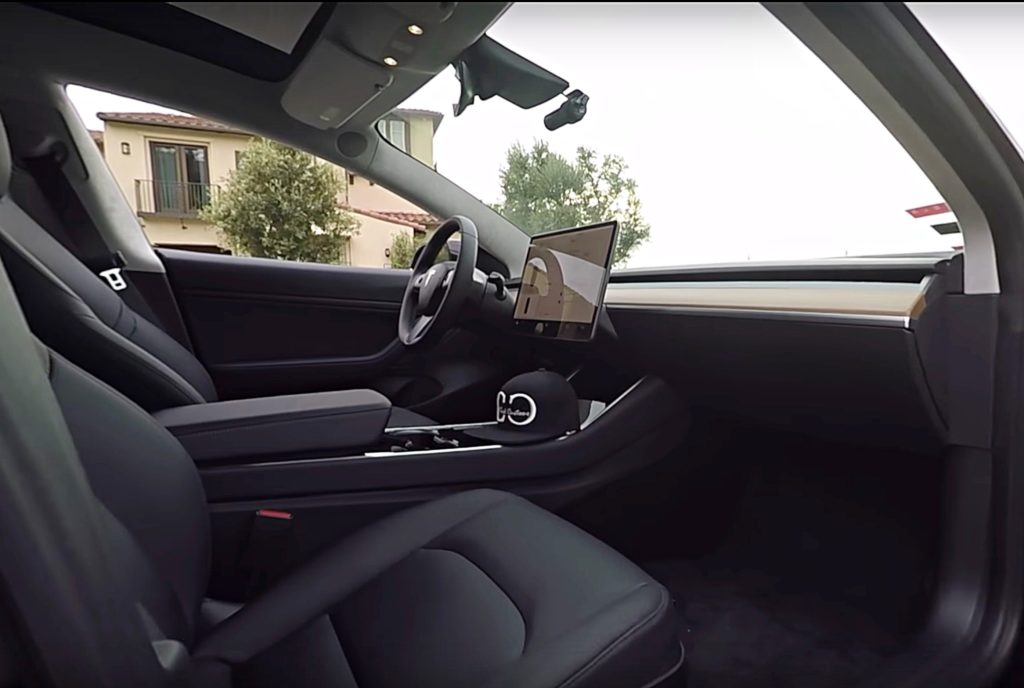
Tesla Model 3 installed with a 1080P dash cam solution
Three quibbles:
1. The standard gloss black surface of the center console shows every fingerprint, every spec of dust and every droplet of liquid that might inadvertently spill. Therefore, the surface becomes messy very quickly.
2. The center console surface is smooth and quite attractive, but its smoothness is also a minor liability. The center console is where the driver puts stuff—keys, ID cards, a pencil, even a smartphone when it’s not in its own compartment. As I mentioned, Model 3 is nimble, and during a quick turn, everything the driver places on the center console surface goes flying. It’s happened to me a few times already.
3. In my opinion, the physical height of center console violates the interior design language. It’s unnecessarily high. Hopefully, a future iteration will place the top of the center console at the same height as the seat cushion, allowing this important element to better blend with the interior. Sure, you’ll lose a little vertical storage space, but you’ll gain a better aesthetic.
Exterior Features. I love Model 3’s exterior—clean, simple, and efficient. For sticklers, the panel gaps on my vehicle were consistently good at approximately 4 to 5 mm throughout, indicating a solid manufacturing process. The trunk opening is much larger than many feared it would be and with the rear seats folded down, you can load a 72” L x 36” wide x 16 “H box into the car. That’s a big box! The trunk hatch requires a bit of a push to close.
 |
Above: A look at my Model 3 with the 18″ aero caps (Photo: EVANNEX)
The doors open wide for easy entry. Their signature feature is the J-handles that rotate outward to open. I have two minor quibbles with the doors.
1. The J-handles are very cool, rotating outward with a push on the ‘fat’ part of the handle. The problem is that gripping the handle to pull the door open can be a challenge if you use the wrong hand. On the driver side, your left hand is the one you want to use, but if you’re carrying, say, a grocery bag in your left hand, opening the driver door with your right hand can require a little bit of arm twisting. When you approach the driver door, try to remember to have your left hand free. The opposite applies on the passenger side. From a design perspective, a future improvement might be to have the door handle spring open and stay that way until a pull on the thin end occurs. It would then return to the closed position.
2. You have to be conscious of making sure that your door closes properly. In many cases, a seemingly proper push of the door will leave it slightly ajar. The problem is that the window remains slightly lowered during closing, and if you don’t notice the problem and walk away, its possible for rain to enter your passenger compartment. Be careful with this and check your doors for full closure during your early weeks of ownership.
Suspension and Ride. Most big name reviewers agree that Model 3 is a driver’s car with a tight suspension, very little roll, and nimble response. Its spring suspension allows you to feel the road, and it’s likely that some owners will accuse Model 3 of a harsh ride. I would characterize the ride as typical of a true sports sedan.
 |
Above: In order to improve the 18″ wheel aesthetics, I removed the aero caps, and installed Model S silver center caps (which also fit Model 3), chrome gorilla lug nuts, and black track/red insert wheel bands (Photo: EVANNEX)
But here’s something that you should know. The body sits relatively high above the ground. With standard 18 or 19-inch wheels, there’s a lot of space between the outer perimeter of the tire and the wheel well fender cut out. Those owners who want a closer-to-the-ground look will undoubtedly remedy this with special suspension packages in the aftermarket.
Wheels and Tires. The OEM tire and wheel packages for Model 3 are pretty pedestrian. They get the job done and look okay, but if you’re like me and believe that wheels are probably the most important element, other than body design, to a vehicle’s overall exterior aesthetic, there’s a lot of opportunities for you to improve the look of your Model 3. I moved immediately to make a wheel change.
 |
Above: My Model 3 with new 20″ AG M580 wheels installed (Photo: EVANNEX)
It is true that there are considerations you must address before you buy aftermarket wheels—additional cost and the possibility of poor fit or tire interference. It also worth noting that they’re frowned upon by Tesla, but that won’t stop tens of thousands of Model 3 owners from making a switch. My advice:
Order your Model 3 with standard 18-inch wheels and tires, then, if you’re so inclined, upgrade to aftermarket 19s or 20s to improve the exterior aesthetic. The EVANNEX-AG staggered wheels on my Model 3 are the 20s, which fit the Model 3 perfectly with no interference, and I think, give the car a very cool premium look with a muscular feel. They’ve already gotten a lot of very positive comments. This approach is somewhat more expensive than opting for the OEM 19s provided by Tesla for a $1600 premium, but I think the result is worth it.
For those that are curious, my wheels are AG M580, 20×8.5 front and 20×10 rear. I opted for Michelin PilotSport 4S tires, 245/35/20 front and 274/30/20 rear. There are other less expensive tire options. By the way, the rolling diameter of the AG 20s and tires is within one percent of OEM 19s, so there is virtually no impact on speedometer or other driving functions.
Summary. I waited almost two years for my Model 3. Overall, it’s exceeded my expectations in almost every category. But like every car, it’s not perfect. I’m confident that Tesla will remedy almost all of the quibbles and minor issues I mention in this post quickly. And for other things, we at EVANNEX will try our best to provide those of you Model 3 owners (or reservation holders) with the ability to make this near perfect car perfect for you.
 |
Above: Loving the new look (Photo: EVANNEX)
Bottom line—the Model 3 was definitely worth the wait!
===
Note: Article originally published on evannex.com, written by Roger Pressman — author of Getting Ready for Model 3, and, founder of Electric Vehicle University. Note: If you’re located in South Florida, feel free to view this Model 3 in-person at a special event this Sunday (just be sure to RSVP).
Elon Musk
X account with 184 followers inadvertently saves US space program amid Musk-Trump row
Needless to say, the X user has far more than 184 followers today after his level-headed feat.

An X user with 184 followers has become the unlikely hero of the United States’ space program by effectively de-escalating a row between SpaceX CEO Elon Musk and President Donald Trump on social media.
Needless to say, the X user has far more than 184 followers today after his level-headed feat.
A Near Fall
During Elon Musk and Donald Trump’s fallout last week, the U.S. President stated in a post on Truth Social that a good way for the United States government to save money would be to terminate subsidies and contracts from the CEO’s companies. Musk responded to Trump’s post by stating that SpaceX will start decommissioning its Dragon spacecraft immediately.
Musk’s comment was received with shock among the space community, partly because the U.S. space program is currently reliant on SpaceX to send supplies and astronauts to the International Space Station (ISS). Without Dragon, the United States will likely have to utilize Russia’s Soyuz for the same services—at a significantly higher price.
X User to the Rescue
It was evident among X users that Musk’s comments about Dragon being decommissioned were posted while emotions were high. It was then no surprise that an X account with 184 followers, @Fab25june, commented on Musk’s post, urging the CEO to rethink his decision. “This is a shame this back and forth. You are both better than this. Cool off and take a step back for a couple days,” the X user wrote in a reply.
Much to the social media platform’s surprise, Musk responded to the user. Even more surprising, the CEO stated that SpaceX would not be decommissioning Dragon after all. “Good advice. Ok, we won’t decommission Dragon,” Musk wrote in a post on X.
Not Planned, But Welcomed
The X user’s comment and Musk’s response were received extremely well by social media users, many of whom noted that @Fab25june’s X comment effectively saved the U.S. space program. In a follow-up comment, the X user, who has over 9,100 followers as of writing, stated that he did not really plan on being a mediator between Musk and Trump.
“Elon Musk replied to me. Somehow, I became the accidental peace broker between two billionaires. I didn’t plan this. I was just being me. Two great minds can do wonders. Sometimes, all it takes is a breather. Grateful for every like, DM, and new follow. Life’s weird. The internet’s weirder. Let’s ride. (Manifesting peace… and maybe a Model Y.)” the X user wrote.
Lifestyle
Tesla Cybertruck takes a bump from epic failing Dodge Charger
The Cybertruck seemed unharmed by the charging Charger.
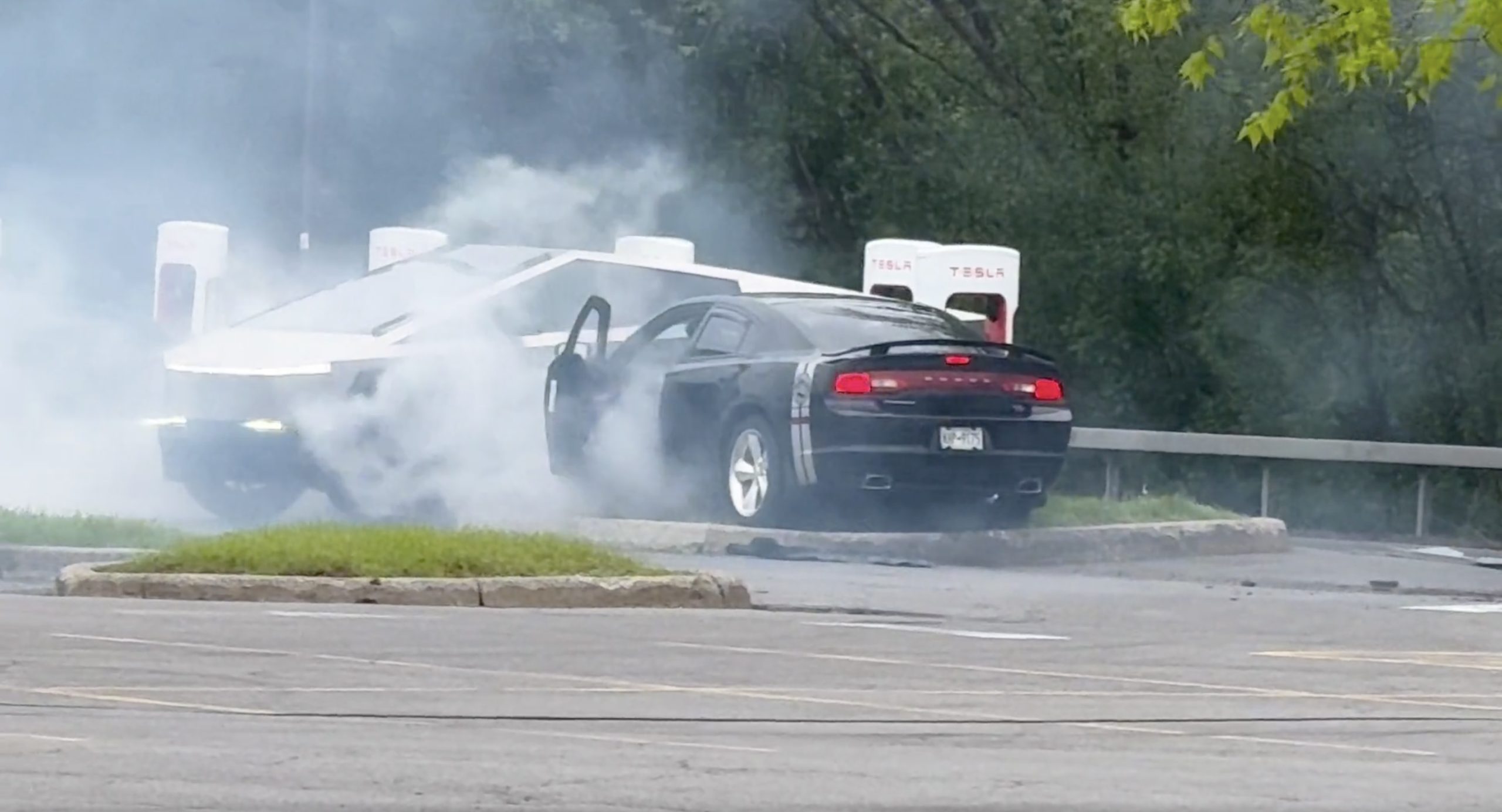
There comes a time in a driver’s life when one is faced with one’s limitations. For the driver of a Dodge Charger, this time came when he lost control and crashed into a Tesla Cybertruck–an absolute epic fail.
A video of the rather unfortunate incident was shared on the r/TeslaLounge subreddit.
Charging Charger Fails
As could be seen in the video, which was posted on the subreddit by Model Y owner u/Hammer_of_something, a group of teens in a Dodge Charger decided to do some burnouts at a Tesla Supercharger. Unfortunately, the driver of the Charger failed in his burnout or donut attempt, resulting in the mopar sedan going over a curb and bumping a charging Cybertruck.
Ironically, the Dodge Charger seemed to have been parked at a Supercharger stall before its driver decided to perform the failed stunt. This suggests that the vehicle was likely ICE-ing a charging stall before it had its epic fail moment. Amusingly enough, the subreddit member noted that the Cybertruck did not seem like it took any damage at all despite its bump. The Charger, however, seemed like it ran into some trouble after crashing into the truck.
Alleged Aftermath
As per the the r/TeslaLounge subreddit member, the Cybertruck owner came rushing out to his vehicle after the Dodge Charger crashed into it. The Model Y owner then sent over the full video of the incident, which clearly showed the Charger attempting a burnout, failing, and bumping into the Cybertruck. The Cybertruck owner likely appreciated the video, in part because it showed the driver of the Dodge Charger absolutely freaking out after the incident.
The Cybertruck is not an impregnable vehicle, but it can take bumps pretty well thanks to its thick stainless steel body. Based on this video, it appears that the Cybertruck can even take bumps from a charging Charger, all while chilling and charging at a Supercharger. As for the teens in the Dodge, they likely had to provide a long explanation to authorities after the incident, since the cops were called to the location.
Lifestyle
Anti-Elon Musk group crushes Tesla Model 3 with Sherman tank–with unexpected results
Ironically enough, the group’s video ended up highlighting something very positive for Tesla.

Anti-Elon Musk protesters and critics tend to show their disdain for the CEO in various ways, but a recent video from political action group Led By Donkeys definitely takes the cake when it comes to creativity.
Ironially enough, the group’s video also ended up highlighting something very positive for Tesla.
Tank vs. Tesla
In its video, Led By Donkeys featured Ken Turner, a 98-year-old veteran who served in the British army during World War II. The veteran stated that Elon Musk, the richest man in the world, is “using his immense power to support the far-right in Europe, and his money comes from Tesla cars.”
He also noted that he had a message for the Tesla CEO: “We’ve crushed fascism before and we’ll crush it again.” To emphasize his point, the veteran proceeded to drive a Sherman tank over a blue Tesla Model 3 sedan, which, of course, had a plate that read “Fascism.”
The heavy tank crushed the Model 3’s glass roof and windows, much to the delight of Led By Donkeys’ commenters on its official YouTube channel. But at the end of it all, the aftermath of the anti-Elon Musk demonstration ended up showcasing something positive for the electric vehicle maker.
Tesla Model 3 Tanks the Tank?
As could be seen from the wreckage of the Tesla Model 3 after its Sherman encounter, only the glass roof and windows of the all-electric sedan were crushed. Looking at the wreckage of the Model 3, it seemed like its doors could still be opened, and everything on its lower section looked intact.
Considering that a standard M4 Sherman weighs about 66,800 to 84,000 pounds, the Model 3 actually weathered the tank’s assault really well. Granted, the vehicle’s suspension height before the political action group’s demonstration suggests that the Model 3’s high voltage battery had been removed beforehand. But even if it hadn’t been taken off, it seemed like the vehicle’s battery would have survived the heavy ordeal without much incident.
This was highlighted in comments from users on social media platform X, many of whom noted that a person in the Model 3 could very well have survived the ordeal with the Sherman. And that, ultimately, just speaks to the safety of Tesla’s vehicles. There is a reason why Teslas consistently rank among the safest cars on the road, after all.
-

 Elon Musk3 days ago
Elon Musk3 days agoTesla investors will be shocked by Jim Cramer’s latest assessment
-

 News1 week ago
News1 week agoTesla Robotaxi’s biggest challenge seems to be this one thing
-

 News2 weeks ago
News2 weeks agoTexas lawmakers urge Tesla to delay Austin robotaxi launch to September
-

 Elon Musk2 weeks ago
Elon Musk2 weeks agoFirst Look at Tesla’s Robotaxi App: features, design, and more
-

 Elon Musk2 weeks ago
Elon Musk2 weeks agoxAI’s Grok 3 partners with Oracle Cloud for corporate AI innovation
-

 News2 weeks ago
News2 weeks agoSpaceX and Elon Musk share insights on Starship Ship 36’s RUD
-

 News2 weeks ago
News2 weeks agoWatch Tesla’s first driverless public Robotaxi rides in Texas
-

 News2 weeks ago
News2 weeks agoTesla has started rolling out initial round of Robotaxi invites

